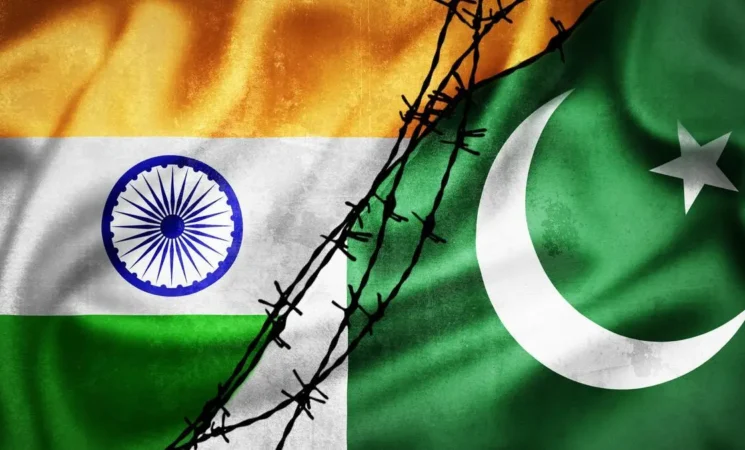01 June 2025, NIICE Commentary 11080
Sriyansh Mohanty & Anoushka Parija
When a tense standoff between two nuclear-armed countries, India and Pakistan, came to a halt—or so it seemed-it came with a conventional set of unanswered questions. After the horrific terrorist attack in Pahalgam that sparked India’s blistering Operation Sindoor, U.S. President Donald Trump claimed credit for brokering a “full and immediate ceasefire”. New Delhi firmly rejected any external involvement, labelling the truce a bilateral “understanding” reached without external interference. But with explosions taking place across the valley, mere hours after the ceasefire’s announcement, casted a shadow over the durability of the same. This shaky ceasefire exposes the high-stakes geopolitical show, where Washington’s hegemonic tendencies, New Delhi’s non-negotiable push for autonomy, and Islamabad’s desperate survival tactics collide in South Asia’s disruptive cauldron.
U.S. Mediation or Furthering Its Agenda?
There’s a necessity of seeing the reality, without joining the bandwagon of people who were very pleased to see Trump back as the U.S. President. The first question as to why Washington jumped into the India-Pakistan quagmire loomed large over the public and the strategic circles. With first guesses, the answer may seem straightforward—to prevent a nuclear war. But amidst all the rhetoric lies a complex web of geostrategic calculations. The United States, just like any nation, will put its national interest first, and India should be wise enough to ditch the rose-tinted glasses and see Washington for the pragmatic dealmaker it is. Despite having one of the strongest partnerships with the US, the Indian leadership failed at convincing their American counterparts to halt Pakistan’s loan sanction at the International Monetary Fund (IMF). As the IMF’s biggest stakeholder, Washington holds the purse strings, and its decision to greenlight Islamabad’s bailout was no spur-of-the-moment call.
The United States smartly set the stage for future talks with India, with every move calculated to benefit the US on the diplomatic chessboard. With the timely bailout easing Pakistan’s economic woes, the Pakistani military can breathe a sigh of relief and shift its energies from financial firefighting back to its core obsession of military posturing. This essentially will ramp up their asymmetric warfare against India. As tensions will escalate, India’s military will ramp up its defences, creating a perfect opportunity for the US to take advantage. The United States will be eager to pitch its high-tech weaponry— think F-35 jets or missile defences—to strengthen India’s defense forces while deepening its own strategic and economic partnership with New Delhi. Washington isn’t playing the peacemaker between New Delhi and Islamabad just for the optics. The US is hopeful that its mediation stirs just enough unease in India’s security circles to set the stage for Indian defense strategists to talk about increasing the military budget, which also helps them with their messaging or should we say sales pitch— “Worried about Pakistan? Strengthen your defences with our shiny fighter jets and top-shelf weapons”. Trump isn’t just here to broker peace—he’s angling towards brokering a blockbuster arms deal, too.
Islamabad’s Shield Cracks
If the dynamics are to be believed and Pakistan pushed for a ceasefire, then it signals a big realisation within the leadership in Islamabad. The Islamic Republic of Pakistan has long used its nuclear deterrent as a shield to dodge India’s retaliation for its proxy terror war. To their dismay, this argument has now become invalid. With Prime Minister Modi’s declaration that India will no longer succumb to nuclear blackmail, a clear message is being sent that New Delhi will also no longer distinguish between Pakistan’s military bases and its terror camps. What it means is that any further attack on Indian soil will invite a response that won’t just be demonstrative, but a decisive one, a response that is designed to destroy. At this point, Pakistan is facing a strategic nightmare because its nuclear doctrine, which relied on deterring New Delhi’s conventional might, has failed. And once the military brass in Rawalpindi starts questioning this very resilience of their nuclear arsenal, then the very logic that held their strategic stability will start crumbling.
Beijing’s Shadow in the Equation
The decision of a ceasefire cannot be viewed in isolation, especially with China turning up as Pakistan’s all-weather friend. Both countries have deepened their partnership in light of the China-Pakistan Economic Corridor (CPEC). It has also increased Islamabad’s strategic dependence on Beijing, making it a critical component in China’s ambitions. In view, New Delhi’s acceptance of a ceasefire may have been strategically planned to avoid escalation of any kind, which could embolden China to strengthen Pakistan economically or militarily, further complicating India’s security along the Line of Actual Control (LAC). Moreover, Washington’s role must be seen through the prism of its geopolitical rivalry with China. By assisting Pakistan in its IMF bailout, the U.S. seems to be on the assumption that it has done enough to keep Pakistan within its sphere of influence and further prevent it from becoming a proxy state for China. From New Delhi’s perspective, neutralising Pakistan’s role as Beijing’s foothold in South Asia would help in diminishing Islamabad’s strategic leverage and also limit China’s ability to project power in India’s backyard. This perspective also fits well within the American strategic circle of having India as a counterweight to China.
India Acts, not Asks, in Defense of Its Sovereignty
A mere statement from the United States doesn’t imply that India is on board on a policy level. New Delhi, being cautious about the recent geopolitical changes, won’t rubber-stamp Washington’s mediation without weighing its own strategic interests first. By neutralizing a hostile Pakistan that serves as a strategic foothold for Western and Chinese interests, India must aim at eliminating existential security threats and dismantling the leverage that is wielded by external powers in its backyard. This will allow India to control more geopolitical variables and tighten its grip on the regional dynamics and gain meaningful influence in world affairs. Crucially, neutralising Islamabad’s strategic constraints could unlock the leverage New Delhi needs to supercharge its economy and Comprehensive National Power, sustaining rapid growth from a formidable base.
There’s no denying the fact that India’s red lines were breached, especially given the course of events that happened. New Delhi has never really acknowledged or appreciated any kind of interreference, let alone mediation, on the matter of Kashmir with Pakistan. External Affairs Minister S. Jaishankar firmly insisted to foreign interlocutors that a ceasefire could only be entertained if Pakistan’s military called up the Indian military, which also reflected New Delhi’s refusal to allow Islamabad to hide behind third-party mediation. The motive was to compel Pakistan to confront the reality head-on, especially after India’s precision strikes on the Noor Khan and other air bases. The years of trust developed between Washington and New Delhi received another blow when the U.S. President offered trade deals as bait, contingent on India and Pakistan submitting to his vision. To equate India—a rising global power—with Pakistan, a state that has long been mired in instability with GDP figures comparable with certain states in India, crossed yet another of New Delhi’s red lines. Donald Trump’s brazen declaration that trade could be used a leverage to pressurize India was the last straw. With one reckless remark, he confirmed New Delhi’s worst strategic nightmare—the U.S. isn’t a reliable partner but a self-serving power.
It's time for New Delhi to be realistic. Relying on an unpredictable ally who might pull up support at the worst possible moment is a sobering thought within the strategic circles. History offers a bad reminder. India remembers Kargil. As soldiers battled Pakistani intruders in the Himalayas, the U.S. refused to share critical GPS data. That betrayal still echoes in the corridors of the South Bloc. Trump has essentially reminded India that American assets could turn into liabilities if Washington decides to play hardball. For an emerging power like India to cement its place as a global power, any kind of dependence on a volatile partner is a striking vulnerability.
Sriyansh Mohanty is a Doctoral Researcher, School of Social Sciences and Humanities, Sharda University, India & Anoushka Parija is a Postgraduate in Political Science, University of Delhi, India.

